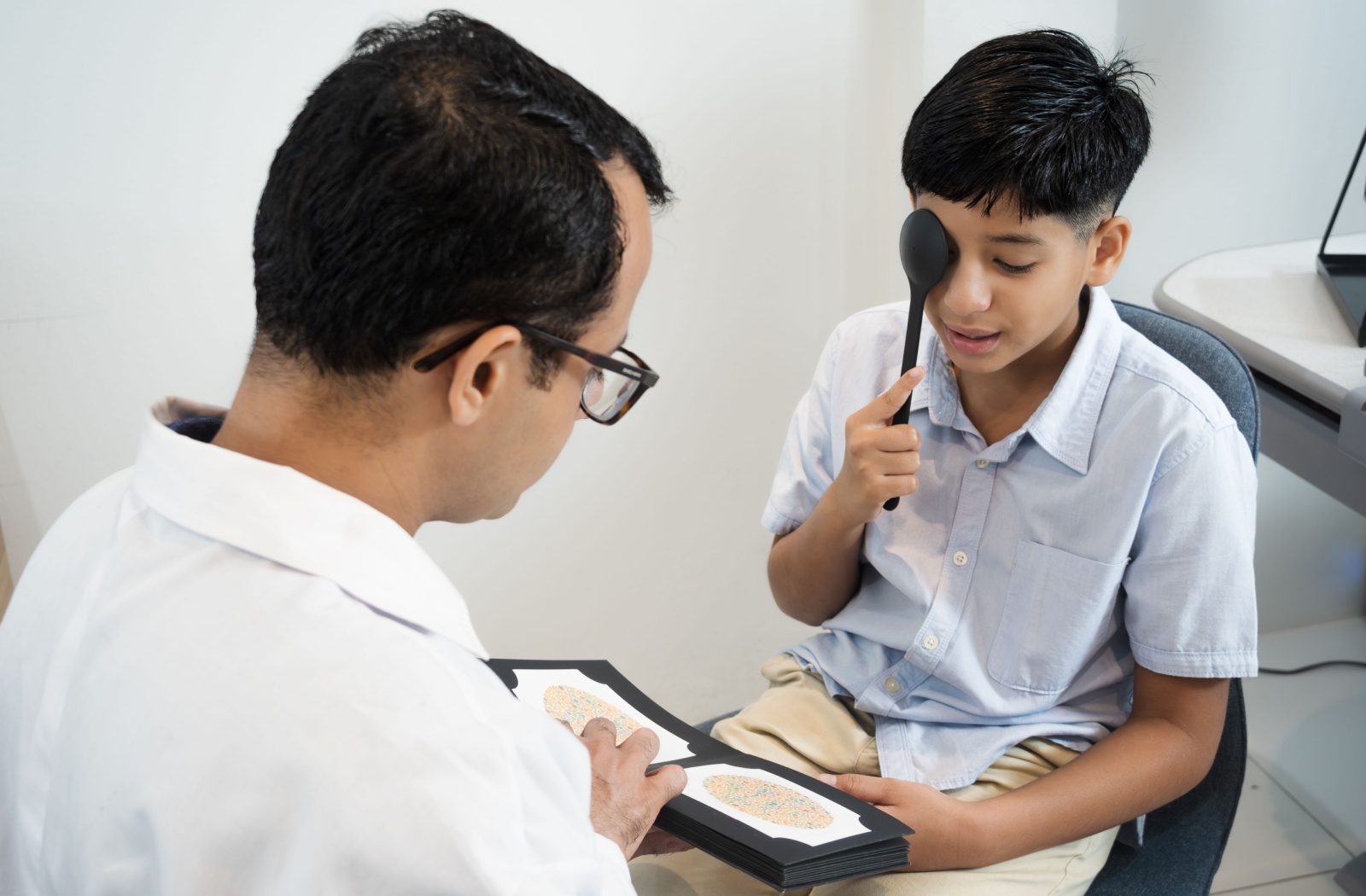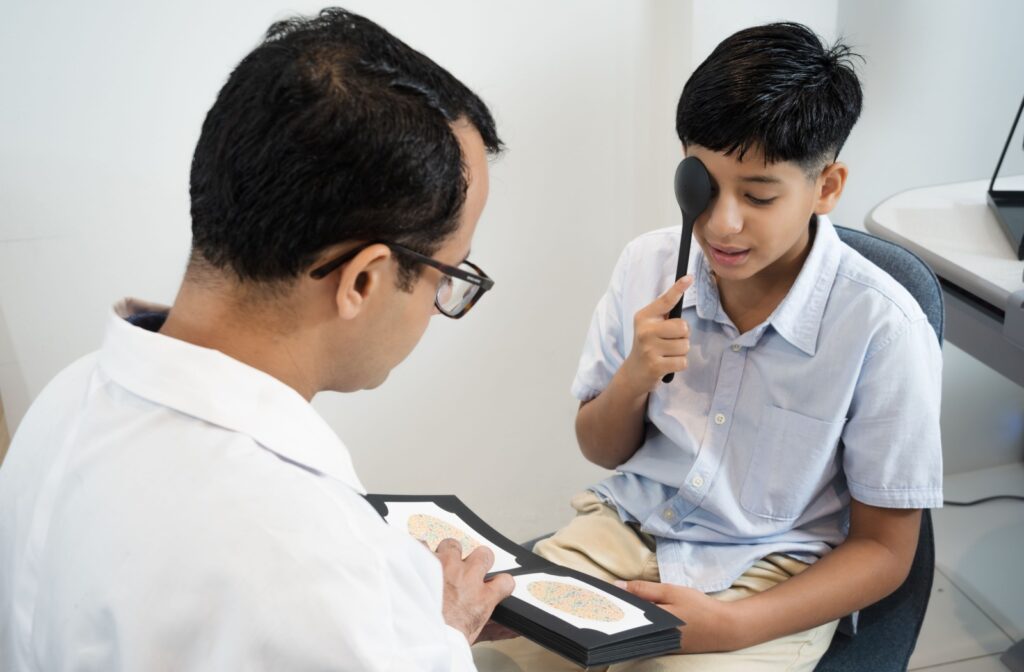Myopia is a prevalent condition among children and youth. Myopia typically stops progressing in early adulthood, but it can worsen with age, depending on a person’s eye health and lifestyle factors.
Fortunately, there are several myopia control methods that your child’s eye doctor can incorporate in their eyecare plan to slow or stop myopia progression. This can prevent myopia from progressing into high myopia, which has several vision-threatening complications.
If your child is experiencing any myopia symptoms, the first step is a comprehensive children’s eye examination. Your child’s eye doctor can provide tailored advice and correction options after the exam.
Understanding Myopia
Myopia, commonly known as nearsightedness, is a vision condition where close objects are seen clearly, but distant objects appear blurry. This occurs when the eyeball is too long, or the cornea is too curved, causing light rays to focus in front of the retina instead of directly on it. Symptoms of myopia include:
- Blurry distance vision
- Squinting
- Eye strain
- Headaches
- Difficulty seeing at night
- Trouble focusing in school
- Short attention span
- Holding things closer to the face
Causes of Myopia
There are various risk factors and causes that contribute to myopia development.
Genetic Factors
Genetics plays a significant role in myopia development. If one or both parents are nearsighted, their children are more likely to be, too. Studies suggest that multiple genes influence eye growth and development.
Environmental Factors
While genetics set the stage, environmental factors can act as triggers. Children who spend a lot of time on close-up tasks like reading, gaming, or using devices are at higher risk. Reduced outdoor activities also contribute, as natural light and looking at distant objects are crucial for eye health.
Lifestyle Influences
Modern lifestyles encourage prolonged screen time, which strains the eyes. Inadequate lighting while reading or working, improper posture, and insufficient breaks can all exacerbate myopia progression.
Understanding these causes helps us take preventive steps and seek timely interventions.
How Age Affects Myopia Progression
Research indicates that myopia typically progresses rapidly during childhood and adolescence, stabilizing in early adulthood. However, some adults may still experience changes in their prescription. Factors such as lifestyle changes, continued close-up work, and overall eye health can cause a myopic refractive error to worsen.
Benefits of Myopia Control
Early myopia control offers numerous benefits, particularly for children. Controlling myopia progression can help maintain better vision throughout a child’s life, reducing the need for stronger prescriptions and frequent changes in glasses or contact lenses.
More importantly, effective myopia control can significantly lower the risk of developing eye diseases associated with high myopia. Conditions like retinal detachment, macular degeneration, and glaucoma are less likely to occur when myopia progression is managed from an early age. This leads to better long-term eye health and reduces the likelihood of vision-threatening complications later in life.
Additionally, myopia control can enhance a child’s quality of life by allowing them to participate in activities that require clear distance vision, such as sports and outdoor play. It can also boost their confidence and academic performance by reducing the visual strain experienced during reading and screen time.
Myopia Control Methods
Managing myopia effectively involves several strategies. Here are some detailed methods to consider:
Atropine Eye Drops
Atropine eye drops are used to slow the progression of myopia in children. Low-dose atropine has been shown to be effective in reducing the rate of progression, making it a popular choice among optometrists.
Orthokeratology (Ortho-K)
Ortho-k involves wearing specially designed contact lenses overnight to temporarily reshape the cornea. This method can improve daytime vision without the need for glasses or contact lenses and has been found to slow myopia progression in children.
Multifocal Contact Lenses
Multifocal contact lenses have different zones for distance and near vision, which can help control myopia progression. They are a convenient option for those who prefer not to wear glasses.
Lifestyle Changes & Environmental Factors
Encouraging outdoor activities and reducing screen time can impact myopia progression. Simple changes like taking regular breaks during close-up work and ensuring proper lighting can also help.
Preventing Myopia
While genetics can’t be changed, lifestyle modifications can help prevent or slow myopia progression.
Encourage Outdoor Time
Spending more time outdoors, especially in natural light, has been shown to reduce myopia progression in children. Encourage activities like sports or nature walks.
Limit Screen Time
Monitor and limit time spent on screens. Encourage regular breaks using the 20-20-20 rule—every 20 minutes, look at something 20 feet away for at least 20 seconds.
Regular Eye Exams
Regular eye exams are essential, especially for children. Early detection and intervention can prevent myopia from worsening. The American Academy of Ophthalmology recommends that most people get a comprehensive eye examination every 1 to 2 years based on age and eye health.
Discuss Your Concerns with the Eye Doctor
Myopia isn’t uncommon and cannot always be prevented, but it’s typically manageable—especially with an early diagnosis. Call our team at Luminance Vision today to request an appointment for your child. One of our experienced optometrists can examine your child’s eyes, discuss the symptoms they’re experiencing, and offer tailored advice and correction options.




